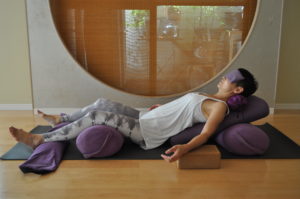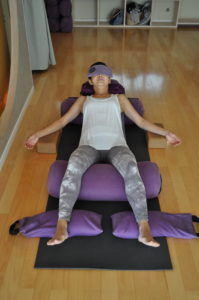
by Leza Lowitz
My favorite Restorative Yoga pose is Empress pose because it gives such a wonderful feeling of full support and ease, allowing the body and mind to deeply relax. I hope you will find many hours of peace and healing by practicing it.
This supported, relaxing version of Savasana releases lower back pain and pelvic discomfort, opens your chest, shoulders and heart while gently stretching your spine and calming the nervous system. It also increases blood circulation to the pelvis, abdomen, heart, and lungs.
It is calming, soothing, and helps restore emotional imbalances so I recommend it for those dealing with stress, insomnia, exhaustion, and menopause as well as for anyone who just needs some quiet time to relax and restore.
Setting Up
To set up for the pose, you’ll need the following: 1 yoga mat, 2 bolsters, 2-6 blocks, 2 or more blankets, and a neck pillow. An eye pillow and 2 sandbags are optional. If you don’t have bolsters, you can use pillows or rolled-up blankets. You can also use a rolled-up towel instead of a neck pillow and a silk scarf as an eye pillow. For sandbags you can use bags of rice or other grains.
Start by spreading a yoga mat on the floor. Towards the upper half of the mat, place a support—a block or stack of blankets folded into narrow rectangles— under your bolster. Now place the bolster or rolled-up pillow vertically on the support so the bolster is at a diagonal, like a slide. Place a rolled-up blanket or pillow on the lower part of the mat (for under your knees). Place a rolled-up blanket or towel on top of the vertical bolster to go under your neck, or under the head, whichever you find most comfortable.
To come into the pose, sit down on the mat in front of the bolster with bent knees, and scoot back so your lower back is right up to the edge of the bolster. Then lie back on the bolster and make sure the support for your head is in the right place.
Place your legs over the rolled-up blanket or pillow on the lower part of the mat so it supports the backs of your knees. If you’re using sandbags, use them to support your ankles, as shown in this photograph. Finally, if desired, cover your eyes with an eye pillow.

As you release into the pose, allow your buttocks to melt into the ground and your lower back to rest against the bolster. Let your hips roll open naturally and allow your legs to melt into the surface.
Settle into the pose so that you are comfortable and allow your chin to rest toward your chest to activate a relaxation response and turn off the Reticular Activating System (RAS).
Make sure you are evenly laid out, supported, and comfortable. If your arms and hands don’t rest easily on the ground, you can add a support under them, such blocks or folded blankets or towels. Place the props to the sides of the bolster to support your arms and hands, particularly under the elbow and wrist joints. If desired, cover your body with a blanket or shawl, cover your eyes with an eye pillow or soft scarf, and allow yourself to relax and be truly supported.
Practicing the Pose
Sense all the places you feel your body making contact with the props and the ground. Take several slow, deep breaths to release your weight, melting into the support.
Bring your awareness to your front body. As you inhale, soften your belly, ribs, and chest. As you exhale, melt into the support, releasing.
Notice the sensations in your body and any emotions that arise. Notice without judgement, holding them in loving awareness.
You can also try releasing tension, stress, anxiety, worry and exhaustion on the exhalation and cultivating cultivate peace, self-love, and comfort on the inhalation.
Stay from 5-15 minutes as long as there is no discomfort. When you’re ready to come out, slowly take your time to roll onto your right side and enjoy a few quiet breaths before coming up slowly, head last.
You can read more about Leza’s writing at www.lezalowitz.com and about her yoga studio and classes at www.sunandmoon.jp.
Follow Yoga for Healthy Aging on Facebook ° To order Yoga for Healthy Aging: A Guide to Lifelong Well-Being, go to Amazon, Shambhala, Indie Bound or your local bookstore.


I am relaxing just reading about this pose. Thank you for the in-depth nature of your posts.